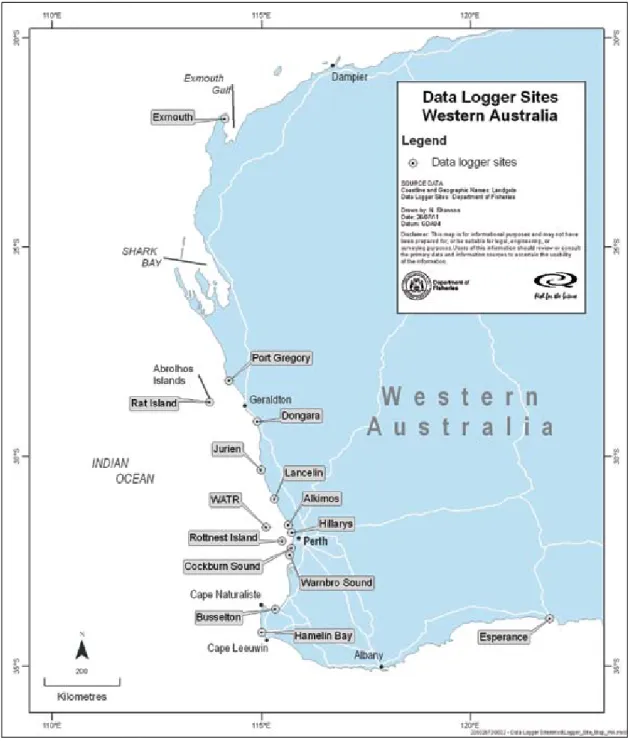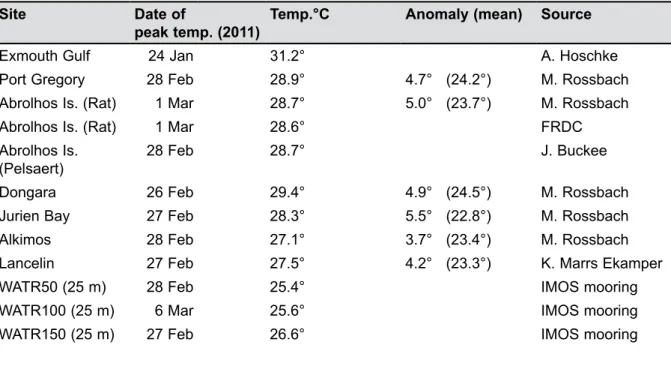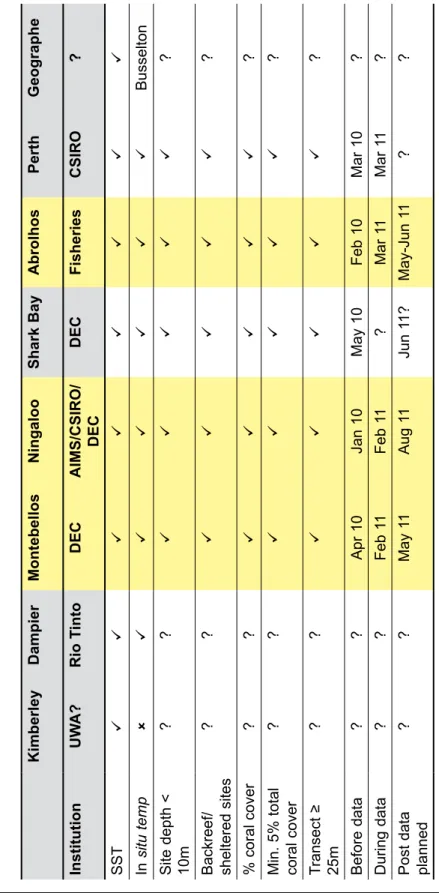Executive Summary
Introduction
Due to the important implications for the marine ecology and commercial and recreational fisheries off Western Australia, a workshop was held on 5 May 2011 at the Western Australian Fisheries and Marine Research Laboratories, Hillarys, to review the oceanographic, ecological and fisheries implications of marine heat wave.
Workshop Objectives
Workshop outcomes/reports
Scope of this report
Presentation summaries
The Leeuwin Current and ocean temperatures off Western Australia in
Similarly, sea level anomalies in Fremantle (the difference between the monthly mean sea level and the long-term mean for that month) were at record highs during the period of the heat wave, indicating a very strong Leeuwin current for this time of year. The strong La Niña condition was superimposed on a dozen amplifications of the flow-through and Leeuwin Current identified over the past 2 decades - these relationships are explored in more detail by Pearce &.
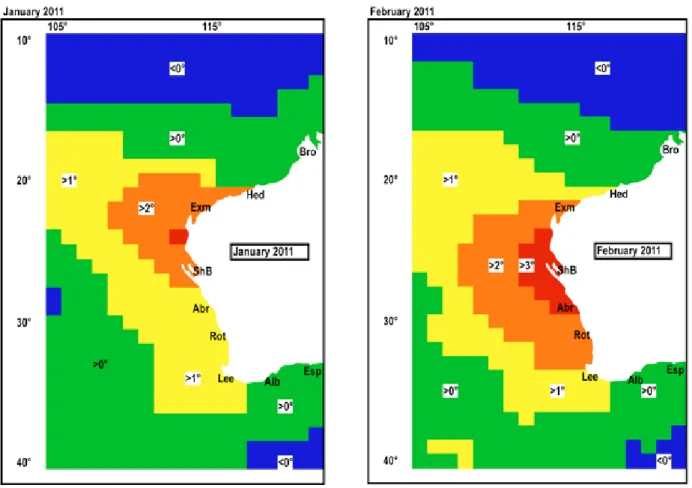
Dead fish - simmered or chilled?
Unprecedented bleaching of Western Australian reef corals
Unusual biological events coinciding with warm ocean conditions along the
Lobster and abalone mortalities
Prawn recruitment trends and scallop growth in Shark Bay during 2010/11 -
A significant increase in SST between 26 and 30°C in late February appears to have been the trigger, arriving after at least 2 months of elevated water temperatures.
Observations on the effects of high water temperatures at the Houtman
Detecting ecological impacts of the 2011 heatwave through benthic monitoring 13
I have been researching the recruitment of tropical reef fish on Rottnest Island for nearly 40 years. While many sites around the island have been regularly surveyed, I've done most of my work in the lagoon at Parker Point, often referred to as Pocillopora Reef because of the abundance of tropical coral Pocillopora damicornis there. In most years, recruitment of juvenile tropical fish begins in the fall and continues into winter.
Since 2000, levels of tropical recruitment have been low at the island, particularly in 2010 when only low numbers of new recruits were observed. At the start of 2011, however, water temperatures began to rise well above the norm, reaching almost 27°C in the deeper waters off Parker Point and nearly 28°C in the lagoon in February. At the same time, a large number of recruits from the tropical damselfishes Abudefduf sexfasciatus and A.
The number of fry on these reefs was at an all-time high in May, and new recruits are still settling in. At least 6 new tropical fish records have been recorded for Rottnest Island so far. To date (May 2011), new recruits of 38 tropical reef fish species have been recorded in Parker Point Lagoon.
Some new visitors to the Busselton Underwater Observatory
Over longer periods of time (ie > 5 years) the structure of macroalgae and fish assemblages at key sites has been monitored. These data represent important 'baseline' information on the structure of benthic communities along the West Coast. Spring survival is usually low as water temperatures then approach the lethal limit for many tropical species.
In most years the numbers settling were low, but on several occasions, notably 1999 and 2000, large numbers of recruits settled. Damselfish numbers quickly approached the record levels of 2000, and by April had surpassed them. The final total could be close to the record level of 14 new records found in 2000 as juveniles of the more secretive species begin to emerge from the reefs.
The species that have declined in numbers include the short-tailed nudibranch which has dropped from a sighting percentage of 74% - 80% in March and 2008 to no sightings in March 2011. It should be noted that the Busselton Jetty has recently undergone significant restoration , which can affect the habitat of certain species.
Post-workshop submitted reports
Observed offshore recreational fishing changes during the 2011 La Niña event . 16
Cockburn Sound experienced a warm seawater plume that pulsed through its popular recreational and industrial waters between late February and mid-March 2011. For about three weeks, high water temperatures and generally lower dissolved oxygen conditions compared with the usual summer and early autumn conditions were experienced in Cockburn Sound, Owen Anchorage and Warnbro Sound. During this warm water event, temperatures reached a maximum of 27.58oC in surface water (0.5 m depth) and 26.62oC in bottom water at a 10 m deep site.
Dissolved oxygen (DO) concentrations fell to a minimum of 3.12 mg/L at one location in the deep southern basin of Cockburn Sound, in the middle of the warm water event. The lowest DO concentrations in Warnbro Sound reached 6.39 mg/L in mid-March or the last week of the warm water event. The previously lowest recorded soil DO value for Cockburn Sound was 4.9 mg/L at deeper sites in late February or March in 2003 and 2007, while for Warnbro Sound at site WS4 it was 5.5 mg/L in mid-February in 2009 .
When the temperatures and dissolved oxygen concentrations during this three-week warm water period are compared to average values recorded between 2002 and 2010, it becomes remarkably clear how extreme this event was compared to "usual" summer and early fall conditions. More extreme conditions occurred at the shallower eastern shelf Cockburn Sound sites, although sites in the deep southern basins were also affected by low DO concentrations. After week 13, water temperatures and to some extent dissolved oxygen in the soil quickly returned to median values associated with early fall.
Likely impacts of the marine heat wave on Little Penguins along the
Certainly, however, there were no fish kills or extra-ordinary reports of other marine biota deaths, e.g.
Influence of marine heat wave on tropical marine pest incursions into
However, examination of an adjacent ship revealed a small founder population that had recently been established within one of the ship's sea chests. Growth estimates of de-shipped mussels place an average-sized mussel between 37.1 and 71 days. Calculating a 'foundation date' from these ages places the origin of an average-sized animal in the summer months of January 2011 to March 2011.
This period coincides with an unusual heat pulse occurring along the WA coastline making coastal waters >3 degrees above normal. It is possible that further populations established elsewhere during this heat pulse, but this may not become visible until later in the year. Future climate change projections have water temperatures anywhere from less than one degree to up to 3 degrees above current levels.
With this recent event of a tropical species spawning in our temperate waters, we should prepare for further incursions by many other tropical species.
Overview of Findings – consequences and implications
Mortality events
COMMITTED EVENTS EFFECTS RESEARCH AND MANAGEMENT IMPLICATIONS Duration Description Short-term Long-term (i) FISH MORTALITY (species range on west and south coasts) √ Temporary localized reduction in stock size of affected species Be aware of possible localization consequences. The decline in stock size in the region north of Kalbarri in fishing area 8 is therefore likely to be long-term. 1/12 catch from both catch sectors Corals (bleaching)√Reduction in size of coral “community” Estimate extent of mortality and likely recovery capacity Starfish (cock crow sound)??Possibly related to elevated SST and unusually low dissolved oxygen Estimate extent of mortality ( ii) AFTER-MORTAL EFFECTS Area expansion.
MADE EVENTS EFFECTS RESEARCH AND MANAGEMENT IMPLICATIONS Duration Description Short-term Long-term Mackerel species (Spanish, spotted)√ Temporary southward range expansion Review any effects of an increased 2011 retained catch in the West and South Coast bioregions Mahi mahi√. Recruits are unlikely to survive through the winter. Inform the (diving/viewing) community of the enhanced recruitment event Gamefish - Exmouth south. Change in species composition of the catch,. MADE EVENTS EFFECTS RESEARCH AND MANAGEMENT IMPLICATIONS Duration Description Short Term Long Term Shark Bay King shrimp√Along with higher catchability, contributed to increased catches.
Temporary increase in strength and diversity of recruitment See above Reduced growth rates Shark Bay and Abrolhos scallops√Likely to lead to lower catches Ensure sufficient breeding stock is maintained for the following season Changed trophic relationships Australian salmon Little penguins. Lower catch rates, changed species composition, poor condition of landed fish When formal monthly catch and effort statistics (CAES) are available, check the extent of the changes. Improved catch rates Exmouth blue swimming crabs√. Possibly related to improved catchability (and improved recruitment that had occurred before the warming event).
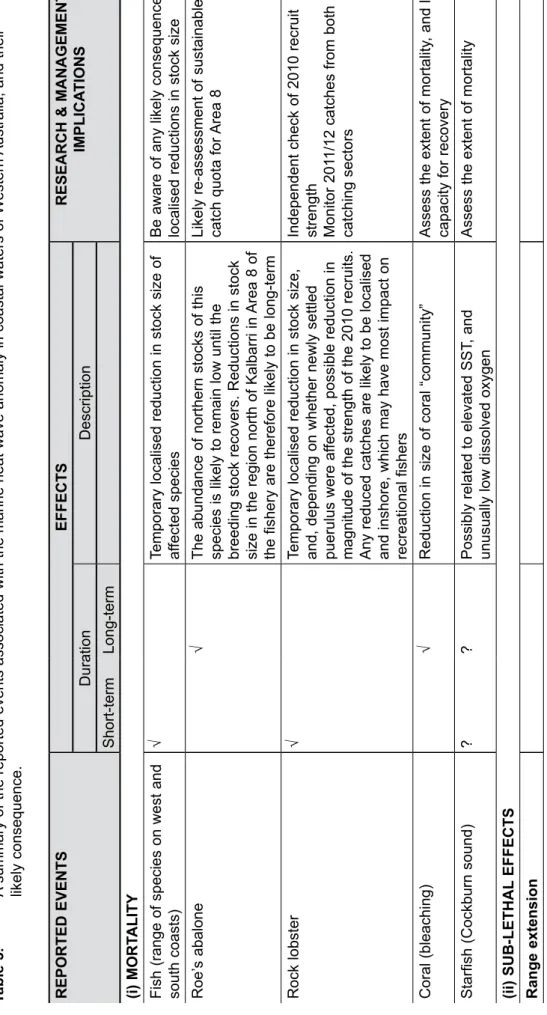
Sub-lethal effects
There were several cases of altered fishing rates reported by the commercial fishing industry (Table 3). From the point of view of catches taken by fishermen, increasing or decreasing the catch rate can have positive and negative effects, respectively. However, from a fishery stock perspective, a positive outcome of improved catch rates for fishermen (if not managed well) has the potential to result in depletion of breeding stocks, and thus may have a negative effect on the stock.
Under such circumstances, it is therefore extremely important to monitor ongoing catches from all exploitation sectors to ensure that the total catch remains within the acceptable range to ensure ongoing sustainability. Most of the fisheries management responses presented in Table 3 are covered in the ongoing monitoring and assessment protocols currently in place at the Department of Fisheries. Indeed, provision is now made under the Ecosystem-Based Fisheries Management (EBFM) arrangements to identify and adequately address any wider ecological risks affecting fish and their dependent habitat.
Relationship with the El Nino cycle and climate change
Likely management responses and priorities for future research
Environmental Monitoring
Maintenance of a coastal monitoring database
WA coral reefs and other coastal marine communities
Exploited species
The extent to which catches of most other exploited species were affected by the heat wave should become clearer once the 2010/11 CAES data and creel/phone diary survey data have been analyzed and reported. This should clarify the extent to which the stocks of Spanish mackerel, Australian salmon and herring have been affected. Depending on the results, the current assessment level for these species may need to be revised.
Invasive species
Acknowledgements
Appendices
Workshop Agenda
Curtin = Universiteit van Curtin. CSMC = Cockburn Sound Management Council) DEC = Department of Environment and Conservation DoF = Department of Fisheries.
List of Registered Attendees
Records of individual observations during 2011
Spanish mackerel observed in large schools (previously here in low numbers) Hillarys Marina 20 March Damselfish (Abudefduf. Rottnest Island) New records of redfish,. redfin butterflyfish, three-spotted dascyllus, johnston damsel, six-banded parrotfish, dusky parrotfish. Mandurah juvenile bat fish, whale commercial fishermen) Busselton Jetty late February raccoon butterfly, reef. observatory manager) Eagle Bay (near.
